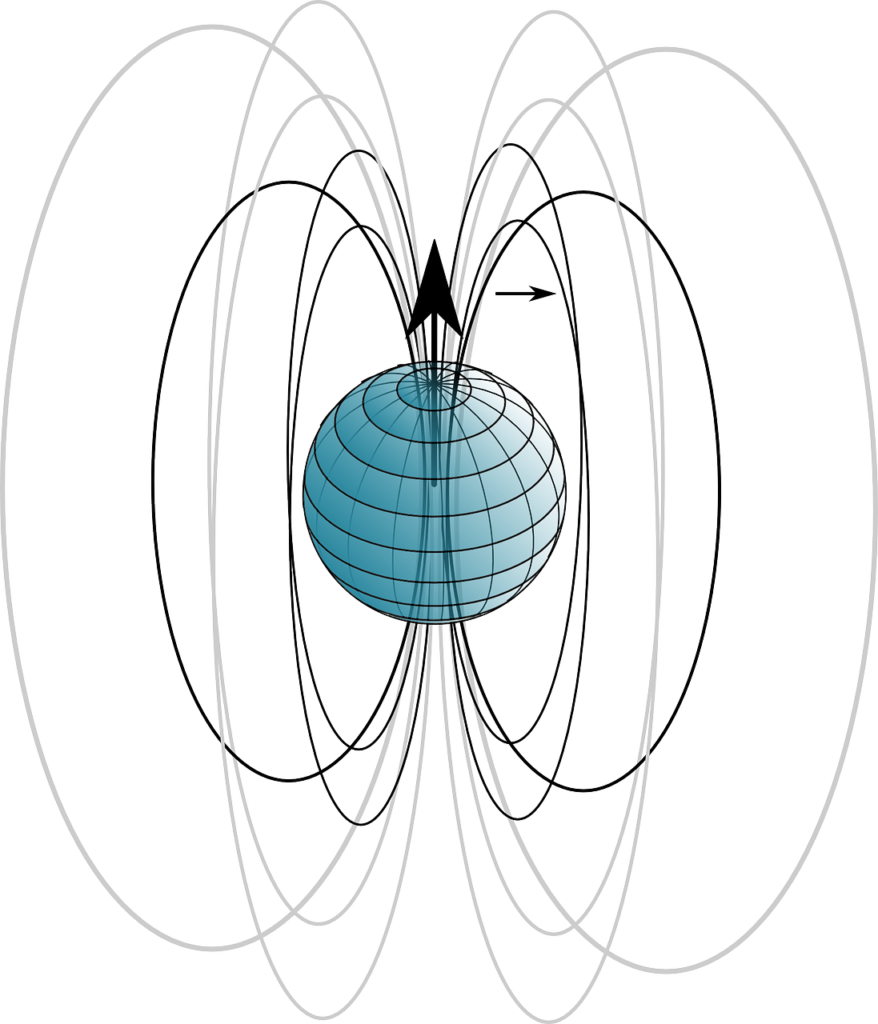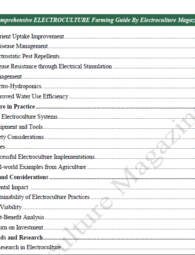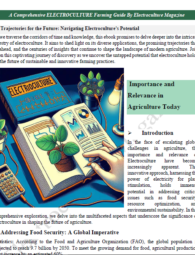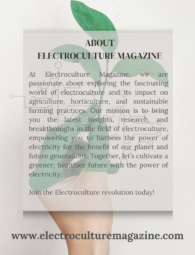Welcome to ElectroCulture Magazine, where we explore the intriguing world of electroculture and its innovative approaches. Today’s essay delves into the novel technique of electrostimulation and its influence on creating robust plant environments. The regulated use of electrical currents to stimulate plant growth, increase yields, and improve overall plant health is known as electrostimulation. Join us as we investigate the science underlying this technology, its advantages, and its potential to transform sustainable agriculture.
Whether you’re a devoted gardener, a farmer, or simply interested in cutting-edge agricultural methods, our goal is to present you with relevant articles that will both inspire and enlighten you. Prepare to discover the thrilling mysteries of electroculture!
What is Electrostimulation?
A method called electrostimulation uses electrical currents to activate biological processes. It is sometimes referred to as electrical stimulation or electrotherapy. The regulated application of electrical currents to plants to promote growth and enhance various aspects of their development is known as electrostimulation in the field of electroculture.
To protect the safety of the plants, the electrical currents employed in electrostimulation are normally low-voltage and carefully controlled. Depending on the intended result, these currents can be administered directly to the plant’s root system, leaves, or even particular plant tissues.
It is thought that electrostimulation has a number of advantageous impacts on plants. It can accelerate cell division and elongation, encourage root growth, improve nutrient intake, and increase plant metabolism in general. Electrostimulation has the potential to raise crop yields, strengthen plant resistance to pests and diseases, and improve the quality of agricultural output by enhancing these fundamental processes.
Although electrostimulation is still a relatively new practice in the field of electroculture, it has great potential as a cost-effective and sustainable way to maximize plant growth and output. The full potential of electrostimulation and its practical uses in many agricultural contexts are still being explored via ongoing study and testing.
Equipment required in Electrostimulation
The equipment required for electrostimulation depends on the specific application. However, some common pieces of equipment include:
- Electrostimulator: This is the main device that generates the electrical current. It typically has a control panel with settings for frequency, intensity, and pulse width.
- Electrodes: These are the pads that are placed on the skin to deliver the electrical current. They come in a variety of shapes and sizes, and they can be made from different materials.
- Gel: This is a conductive gel that is applied to the skin between the electrodes. It helps to improve the conductivity of the skin and reduces the risk of skin irritation.
- Lead wires: These are the wires that connect the electrodes to the electrostimulator. They come in a variety of lengths, so you can choose the right length for your application.
- Buy Our Handcrafted Electroculture eBook Now…
In addition to these basic pieces of equipment, there are a number of other accessories that can be used with electrostimulation, such as:
- Vests: These are garments that have electrodes sewn into them. They are a convenient way to apply electrostimulation to multiple muscle groups at once.
- Bandages: These are similar to vests, but they are made of a more flexible material. They are a good option for people who want to apply electrostimulation to specific muscle groups.
- Applicators: These are handheld devices that deliver the electrical current directly to the skin. They are a good option for people who want to target specific areas of the body.
When choosing electrostimulation equipment, it is important to consider the following factors:
- The type of electrostimulation you want to use: There are two main types of electrostimulation: neuromuscular electrical stimulation (NMES) and transcutaneous electrical nerve stimulation (TENS). NMES is used to contract muscles, while TENS is used to relieve pain.
- The intensity of the current: The intensity of the current will depend on the application. For example, NMES for muscle building typically uses a higher intensity than TENS for pain relief.
- The duration of the treatment: The duration of the treatment will also depend on the application. For example, NMES for muscle building typically uses a shorter duration than TENS for pain relief.
- Your budget: Electrostimulation equipment can range in price from a few hundred dollars to several thousand dollars. It is important to choose equipment that fits your budget and your needs.
If you are considering using electrostimulation, it is important to talk to your doctor first. Electrostimulation can be a safe and effective way to improve your health, but it is important to use it correctly.
procedure for Electrostimulation
The procedure for electrostimulation as an electroculture technique can vary depending on the specific goals and plants involved. However, here is a general outline of the steps involved in electrostimulation:
- Equipment Setup: Ensure that all the necessary equipment, including the power supply, electrodes, conductive solution, and controller, are set up properly and in accordance with safety guidelines. Make sure the power supply is connected to a reliable power source.
- Preparation of Conductive Solution: Prepare the conductive solution by mixing water with appropriate electrolytes to create a solution that enhances electrical conductivity. The specific composition of the solution may vary depending on the plants and experimental requirements.
- Electrode Placement: Determine the appropriate placement of electrodes based on the target plant or plant tissue. Electrodes can be inserted into the soil near the plant’s roots or placed in contact with specific parts of the plant, such as the leaves or stems. Ensure that the electrodes make good contact with the plant tissues.
- Current Application: Set the desired parameters on the controller or regulator, including the intensity, duration, and frequency of the electrical currents. Start with low-intensity currents and gradually increase as needed. Apply the electrical currents according to the established protocol, ensuring that the plants receive the desired stimulation.
- Monitoring and Observations: Monitor the plants closely during and after electrostimulation. Observe any visible changes in growth, development, or overall health. Document and record any relevant data or observations for future analysis.
- Data Analysis and Evaluation: Analyze the data collected from the electrostimulation experiment. Assess the effects of the electrical stimulation on plant growth, nutrient uptake, yield, or other parameters of interest. Draw conclusions based on the results obtained and evaluate the effectiveness of electrostimulation as an electroculture technique.
It’s worth noting that the procedure may require adjustments and modifications based on the specific plant species, growth stage, and desired outcomes. It is recommended to refer to scientific literature, research papers, or consult with experts in the field for more detailed and plant-specific procedures.
Benefits of Electrostimulation
There are many benefits to using electrostimulation for plant growth, including:
- Increased growth rate: Electrostimulation can help plants grow faster and reach their full potential.
- Improved yields: Electrostimulated plants often produce higher yields than non-electrostimulated plants.
- Enhanced nutrient uptake: Electrostimulation can help plants absorb nutrients more efficiently, which can lead to healthier plants.
- Increased resistance to pests and diseases: Electrostimulated plants may be more resistant to pests and diseases, which can help to reduce crop losses.
- Improved quality: Electrostimulated plants often have better quality, such as being more flavorful or having a longer shelf life.
In addition to these benefits, electrostimulation can also be used to:
- Rejuvenate old plants: Electrostimulation can help to rejuvenate old plants that are no longer growing as well as they used to.
- Improve the germination rate of seeds: Electrostimulation can help to improve the germination rate of seeds, which can lead to a higher seedling survival rate.
- Control the growth of plants: Electrostimulation can be used to control the growth of plants, such as by preventing them from growing too tall or too wide.
Electrostimulation is a safe and effective way to improve plant growth. However, it is important to use the correct settings and to follow the manufacturer’s instructions.
Here are some of the specific benefits of electrostimulation for different types of plants:
- Fruit trees: Electrostimulation can help fruit trees produce more fruit and improve the quality of the fruit.
- Vegetables: Electrostimulation can help vegetables grow faster and larger, and it can also improve the flavor of the vegetables.
- Flowers: Electrostimulation can help flowers bloom more profusely and improve the color of the flowers.
- Herbs: Electrostimulation can help herbs grow faster and produce more leaves.
If you are interested in using electrostimulation for plant growth, there are a number of different devices available on the market. It is important to choose a device that is suitable for the type of plants you are growing and that has the features you need.
Final Words
Electrostimulation stands as a compelling facet within the realm of electroculture, showcasing immense promise for agricultural advancement. Its fusion of electrical principles with plant growth has unveiled a realm of possibilities for enhanced crop productivity and resilience. As an innovative technique, it offers a unique pathway to optimize yields, foster plant health, and mitigate environmental stressors.
The method’s evolution continues to draw attention and investment, with ongoing research and technological advancements propelling its efficacy. With its potential to revolutionize traditional agricultural practices, electrostimulation in electroculture emerges as a beacon of hope, offering sustainable solutions to meet the evolving demands of global food production.







